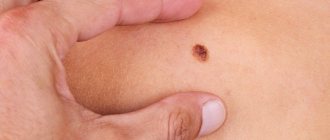Laser mole removal is a procedure that is quickly tolerated by the patient. The main advantage is a good cosmetic result. Depending on the type of mole being removed, different lasers may be used. Whether mole removal will be effective and what the cosmetic result will be after healing depends on the experience of the doctor and the chosen laser.
Of all mole removal methods, laser removal provides the best patient reviews. Especially when removing moles from the face, when the most cosmetic result is important. The procedure is painless (performed under local anesthesia), fast, and causes minimal discomfort. Laser procedures do not limit the patient’s daily activity - frequent dressings are not required, local disinfection is sufficient.
“Will you take a test from the mole the day before?”
The only analysis that can reliably determine the nature of the formation is histological examination. The formation is removed entirely and sent for pathomorphological examination. No “plucking” is performed in advance before removing moles.
It is possible to perform a cytological examination in advance if there is discharge, ulceration or trauma to the formation. This study allows you to establish a preliminary diagnosis and is performed when it is difficult to make a preliminary diagnosis. Often, an external examination or dermatoscopy is sufficient to make a diagnosis. For example, in relation to fibroepithelial polyps (papillomas), keratomas, fibromas, viral warts, a fairly large group of nevi (intradermal, warty, non-pigmented, etc.).
What moles on the face “say”
Since the time of the Inquisition, moles, age spots or birthmarks on a person’s body or face have been interpreted as symbolic. In this case (during the period of the Inquisition) they were regarded as marks of the devil or mystical signs, especially regarding formations on the face or hands. It was believed that Satan himself thus marks those whom he has chosen for his service. Most often, women suffered from this: if there was a mole on her body, and even more so, its location was on her face, then the woman most likely ended up in an Inquisition trial, where her guilt was determined, and the trial was followed by burning at the stake.
But already in the 18th century, the idea of moles and people with moles changed dramatically. This was due to the legend that existed at that time that the face of the goddess of love and beauty Venus was decorated with a mole. Therefore, a mole, and even on the face, was considered a sign of the patronage of Venus, and women of different classes and ages introduced the fashion for so-called flies, usually moles drawn above the lip (as it was believed - for good luck).
Recommended articles on the topic:
- Painless lip modeling: techniques and recommendations
- Beauty injections: types, preparations, reviews
- Eyelash restoration at home and in a beauty salon
Today, when many signs and prevailing opinions are a thing of the past, attitudes towards moles have been revised again. In the modern world, many people are indifferent to them, although various fortune tellers also endow them with sacred meaning and try to determine fate by the moles a person has. There are many articles that describe the meaning of moles based on their location on the body. However, there is no unambiguous assessment of this theory: there are those who unconditionally believe in it, and those to whom this whole version seems unrealistic, illogical and absurd.
We will still try to correlate a person’s moles with his possible fate and future.
There are different approaches to examining moles on the human body and face. One of the most popular is to look at the shape of the mole and its size. It is believed that if a mole is round in shape, it will bring goodness to its owner. A more elongated and oblong mole is a sign of good luck, but a sharp mole symbolizes the uncertainty of life.
If a mole is on the face, namely on the left eyebrow, this may indicate a late marriage, while a mole on the right eyebrow, on the contrary, means an early marriage.
If a mole is located in the area of the lips or directly on the lip, then it is believed that its owner will be endowed with great love, real feelings and generally marked with the sign of Venus, but at the same time, the character of such a person may be distinguished by hypocrisy, some superficiality or frivolity, and also fear loneliness. The same mole can have another interpretation - it can distinguish a person who is cheerful, kind and open to the world.
As soon as you have a mole on your right cheek, stormy love experiences will soon begin in your life, and if on your left, then you will probably soon encounter troubles and troubles.
A mole on the nose symbolizes success in everything and is considered a sign of incredible luck.
A mole located in the corner of the eye is found in a person with a calm and measured character.
We can conclude that the face is the place on which a mole is always a symbol or sign of some qualities or signs. And if you are planning to remove a mole, then you should first look at what it symbolizes. Perhaps this is a mole of total luck, wealth and prosperity, or the best health, and it is no coincidence that it appeared on your body.
Read material on the topic: Laser facial skin rejuvenation: useful tips and recommendations
“Should I remove moles or not?”
There are formations on the skin that need to be removed because there is a high risk of cancer.
Mostly such formations are excised with mandatory histological examination of the surgical material. Benign, non-precancerous skin formations must be removed for cosmetic reasons, in case of unpleasant sensations (trauma, itching), if permanent damage to the formation or other discomfort occurs.
In any case, you should consult a dermatologist or oncologist about whether moles need to be removed. He should also recommend the optimal removal method.
Contraindication for laser treatment
- Oncological diseases, HIV, AIDS, viral hepatitis.
- Chronic diseases in the acute stage.
- Pregnancy and lactation period.
- Infectious and inflammatory diseases.
- Organ failure.
- Severe diseases of the cardiovascular system, diabetes.
- Mental illnesses.
In medical operations for laser removal of moles, they are carried out at a high professional level using modern laser technology of the latest generation, which eliminates the risk of complications or postoperative scars. The operation can be performed at any convenient time on an outpatient basis; after the intervention, you can go about your daily routine; it will not affect your usual lifestyle in any way. You can make an appointment by calling the center or leaving a request on the website.
Ways to remove moles
- Surgical
All formations with minimal suspicion of malignancy are subject to excision within healthy tissue, with mandatory histological examination of the surgical material. Also, the surgical method is preferable for some large formations (more than 1.5 cm) from the point of view of the healing process and cosmetic effect.
- Minimally invasive: laser destruction, radio wave method
- Laser destruction
Most preferred for convex lesions, pedunculated lesions, seborrheic keratomas and warts, including large ones.
The advantage of the method is instant coagulation, without damage to adjacent tissues, without bleeding and instant formation of a crust on the wound. Laser destruction, unlike radioknife and electrocoagulation, does not conduct through the human body and is acceptable in patients with pacemakers and pacemakers.
During the laser destruction process, no ionizing radiation is generated and the impact is limited to the point of application, and is allowed in children and pregnant women. The method is practically non-contact, has a very high temperature at the point of application, and therefore eliminates the possibility of contracting infections such as HIV or hepatitis. The disadvantage of this method is that in most cases the removed material is not suitable for histological examination, so laser destruction is suitable for removing exclusively benign formations that do not raise doubts about the diagnosis.
- Radio wave method
It is a dissection of soft tissues in a non-traumatic manner using narrowly directed high-frequency radio waves, it allows you to make thin incisions with the adhesion of small vessels, sterilization of the surface - the high-frequency radio wave destroys microorganisms.
The method is suitable for removing small formations that require histological examination, since during removal the surgical material is minimally damaged or as an alternative to a scalpel when excising a formation. It has contraindications - pacemakers, epilepsy, glaucoma, diabetes, pregnancy, inflammatory processes in the acute stage.
Not suitable for removing “dry” formations - viral warts, formations with abundant keratosis.
Preparation for the procedure
Before laser removal, the tumor is examined. First, the doctor conducts a visual examination, and then examines the tumor under multiple magnification. Dermatoscopy is a safe, non-invasive and simple diagnostic method that allows detailed visualization of not only the superficial, but also the deep layers of the skin.
Using a laser, only benign neoplasms are removed, since the neoplasm is evaporated and subsequent tissue examination cannot be carried out. If there is the slightest suspicion of a malignant process, the laser cannot be used and removal is carried out surgically with excision of not only the mole, but also part of the healthy tissue.
Before interventions, it is necessary to undergo several tests - tests for blood group and Rh factor, coagulogram, etc.
No special preparation is required for the procedure. The patient arrives at the appointed time. The procedure takes from 5 to 10 minutes, depending on the size of the tumor. To remove moles, a laser knife or erbium laser is used, the operation is performed under local anesthesia.
Laser Application
A dermatologist can offer the patient several ways to remove tumors. Naturally, the patient will give preference to the one that is the least traumatic and painless. Laser removal of papillomas and warts allows you to quickly get rid of the problem.
The microfractional beam evaporates the growth without affecting healthy tissue. To completely remove the tumor, one procedure is sufficient. There are no scars after using the laser. In addition, blood loss is also excluded.
- Diabetes.
- Blood diseases.
- Oncology.
- Pregnancy.
- Autoimmune diseases.
- Tendency to keloid scars.
- Epilepsy.
After the procedure, the wound heals within two weeks. Many patients who have chosen this method of treatment leave positive reviews on the Internet. The consequences of laser removal of papillomas and moles are clean and healthy skin. Just a few days after the procedure, the patient completely forgets about the eliminated growths. There are no side effects after using the laser.
What you need to know about melanoma?
Every mole on the human body can degenerate into a malignant melanoma. What it is? Melanoma is one of the types of malignant tumors. It also contains melanocyte cells (producing melanin), but in melanoma the cells are more aggressive.
They constantly divide, displace healthy cells, enter the vascular bed and spread throughout the body. As soon as the first aggressive cell approaches the brain or, for example, the lungs, it settles inside the organ and begins to rapidly divide. This process is called metastasis.
Melanomas are extremely dangerous because they quickly metastasize and divide at an incredible rate. The main thing is to detect the pathology in time. Surgical removal of melanoma will prevent the process from spreading throughout the body and guarantee a complete cure. Failure to see a doctor in a timely manner or complete refusal of treatment can result in death.
How is mole histology performed?
Thanks to histological examination, cancer cells can be detected even at the stage of their inception.
Indications for mole histology:
- redness of the skin around the tumor;
- small ulcers on the surface of the nevus;
- burning or pain in the mole area;
- change in color, size, shape of the tumor.
Histology is performed with the procedure of surgical excision of the mole. A small tissue sample is removed and sent for further examination. In the laboratory, biological material is placed in a special suspension and examined under a microscope. Diagnosis is based on the analysis of pigment-forming cells - melanocytes. Laboratory testing may take up to 14 days.
Advantages:
- Small vessels become thrombosed.
- Bloodlessness of the operation.
- The surrounding tissues are not injured.
- The possibility of metastases is excluded,
- No traces are left.
- Painless.
- No contact with tools.
- Fast recovery period.
The only drawback is that this method does not allow us to conduct a histological examination. Therefore, it must be done in a medical facility.
Removing birthmarks and port-wine stains
Preparations with a cauterizing effect
Pharmacological companies create various effective and affordable drugs for removing tumors at home. Cauterizing remedies for papillomas help get rid of growths forever. The following drugs can be purchased at the pharmacy:
- “Verrucacid.” It is an oily liquid whose main ingredient is phenol. The substance is quite aggressive. The liquid should be applied with an applicator exclusively to the neoplasm. Care must be taken to ensure that the product does not come into contact with healthy tissue. “Verrukatsid” is applied twice with an interval of five minutes. Usually one procedure is enough. The drug is contraindicated for the treatment of pregnant women and children under the age of seven.
- "Ferezol". This drug has a bactericidal and cauterizing effect. The liquid is applied pointwise, several times over the course of an hour. The procedure is repeated after eight days.
- "Solcoderm". This medicine contains oxalic, nitric, acetic and lactic acid. It is recommended to use the drug under the supervision of a specialist with higher or secondary medical education. “Solcoderm” is applied several times pointwise until the neoplasm takes on a yellowish or gray-white color.
Pharmacy preparations for freezing tumors
A doctor must remove moles. You cannot do this on your own. Otherwise, you can provoke a malignant degeneration of the nevus. You can remove papillomas yourself. Provided that the doctor has previously examined the patient and confirmed the diagnosis. And also approved the method of treatment. To do this, you can purchase a remedy for papillomas at the pharmacy, which freezes tumors. The most effective drugs include:
- "Wartner Cryo". Removes not only papillomas, but also warts. The active ingredient of the drug has a temperature of minus 40 degrees, this is quite enough to destroy the cells of the growth;
- "Veruklin". The mixture of gases of this drug has a temperature of minus 50 degrees. The papilloma completely dies off just two weeks after using this remedy;
- "Cryopharma". Contains propane and dimethyl ether. At the exit from the cylinder, their temperature reaches minus 57 degrees. One package is enough to treat 12 tumors. Within two weeks after the procedure, healthy skin is completely restored.
Cryodestruction
Removing moles and warts using liquid nitrogen does not require pain relief. As a result of cold exposure, nerve fibers freeze and sensitivity is switched off. Liquid nitrogen is charged into a mini-cylinder with removable nozzles. The surgeon selects a tip 1 mm larger than the diameter of the tumor and applies it to the mole. The mole is frozen and rejected on its own. The disadvantage of this procedure is that it is difficult to calculate the depth of nitrogen penetration. If the exposure is too strong, healthy tissues are frozen, and if the exposure is weak, the nevus is partially removed. Damage to healthy tissue provokes cosmetic defects and increases the rehabilitation period.
Laser removal of birthmarks and port-wine stains.
Today it is a very effective and popular procedure. In the distant past, birthmarks on the human body were called nothing more than “the mark of Satan.” Today the attitude towards these entities is not so strict. And they are not credited with mystical or any other secret properties. Almost all people have such spots, regardless of skin color and race. For some people they are small and do not cause any discomfort. And in others they grow to impressive sizes and can cause discomfort. For some they give a special charm, while others simply get used to them. But vascular nevi are not as harmless as they seem. Know that there is always a risk that a birthmark may one day turn into a malignant tumor.










